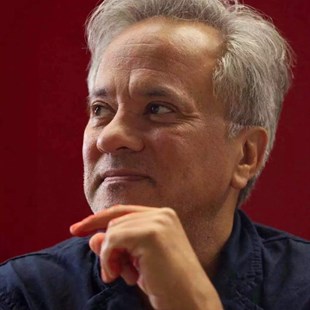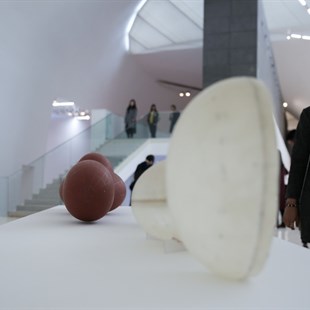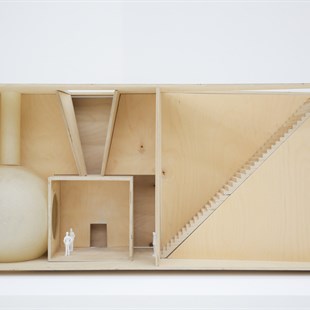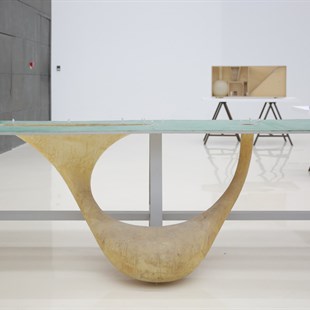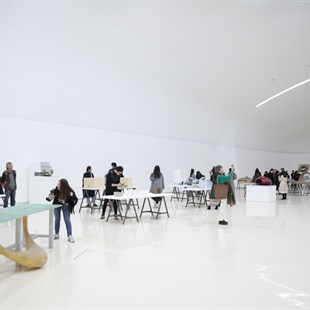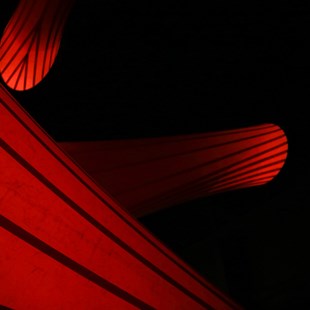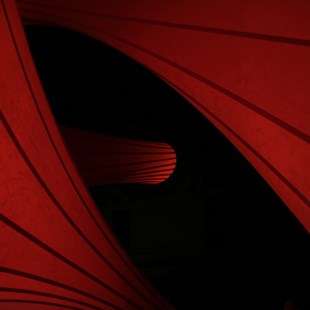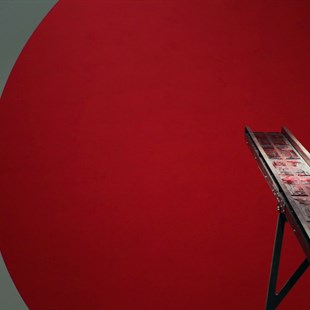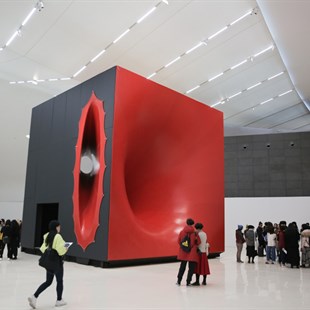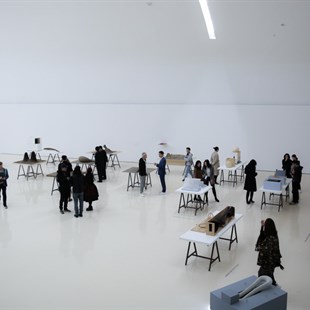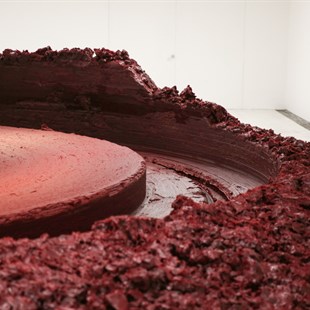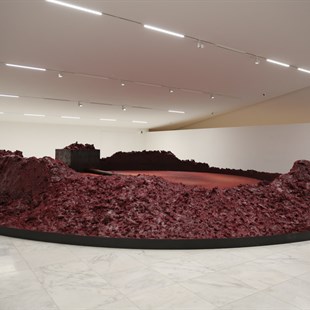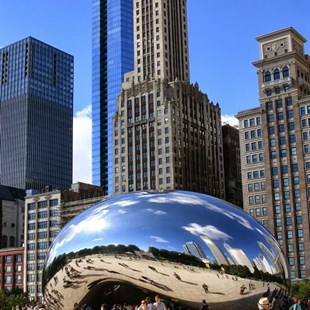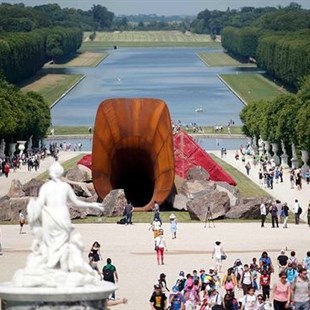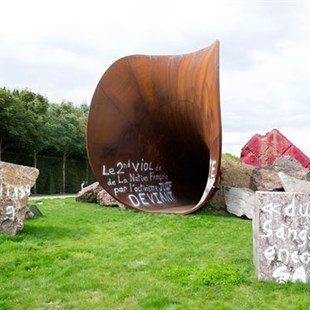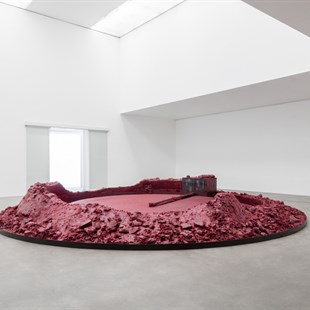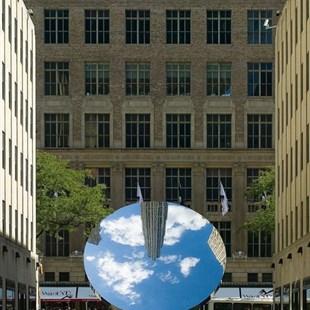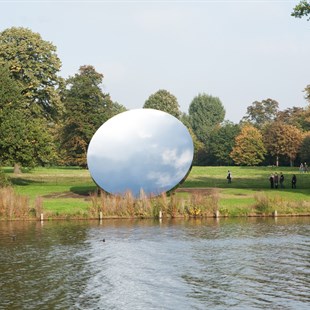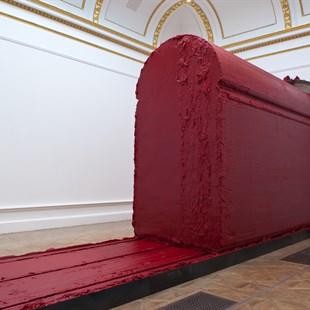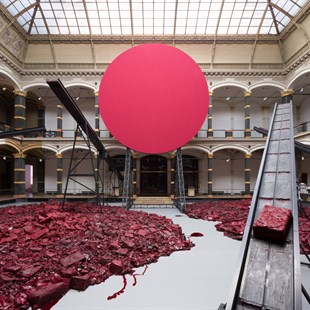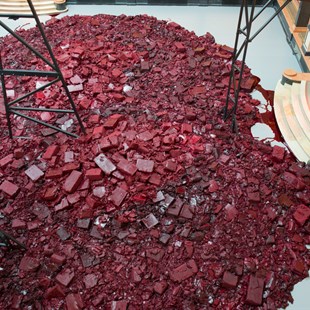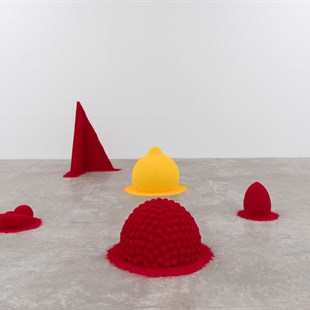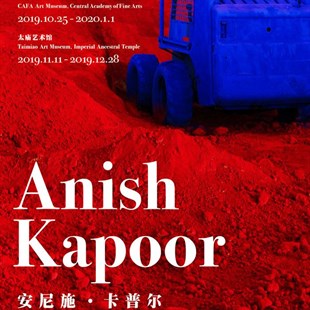
“Red is a colour I’ve felt very strongly about. Maybe red is a very Indian colour, maybe it’s one of those things that I grew up with and recognise at some other level. Of course, it is the colour of the interior of our bodies. Red is the centre.”
—Anish Kapoor, In conversation with John Tusa, 2003
Red is undoubtedly impressive, whether in the context of the East or West, while red is often thought to be related to blood, sacrifice, life, and enthusiasm, conveying a mysterious will and profound ideas. Anish Kapoor loves red, and his work usually reveals a minimalist appearance, but he presents an extraordinary taste of “minimalism”. The red solid wax, the soaring mirrored sky, the invisible refraction of the cloud gate… with a shocking experience they attract attention but they also seem to hide or lead to a poetic experience, revealing some Zen significance.
This is closely related to the artist’s experience and multiple identities. Anish Kapoor was born in Mumbai, India in 1954. His father was Indian and his mother was Jewish. In the early 1970s, he studied electrical engineering in an Israeli farm and later he decided to become an artist. In 1972, he moved to London, U.K., to study at the Hornsey College of Art and the Chelsea School of Art and Design. In 1990 and 1991, he was awarded the Venice Biennale New Artist Award and the Turner Prize, becoming a representative of “New British Sculpture”.
The general minimalist sculptures use the simplest “dots, lines and planes” or a combination of singular geometric shapes, through the repeated stacking, arranging and combination of similar elements to form their own logical laws, creating a mechanized and industrialized, smooth and orderly feeling. He prefers the exploration into “substance”, which draws on the creation of minimalism and reveals the symbol of “physicality” but at the same time retains an ancient mysterious and extraordinary oriental texture.
Red: Oriental Complex and Mystery Theater
In 1979, Anish Kapoor returned to his native India for the first time. After he returned to the U.K., he began to experiment with clay materials and painted them with white chalk 1. This powder has a special meaning in Indian culture: they usually appear in the performance of the ancient Holi Festival ceremony depicting “punishing evil and promoting goodness”. The combination of primary color powder and single geometry has become a commonly used technique. His earlier work A Thousand Names (1979-1982) is a prominent example. The original intention came from Vishnu, the Hindu god who has a thousand names and symbolizes infinity. He describes “the powder that shows the floor and the wall, and part of the object that invades the water, like an iceberg.” The deep mysticism and rich drama make the work full of vitality and these two characteristics run through his creative process.
Anish Kapoor is good at using materials: marble, plaster, wood, stainless steel, glass, resin, wax, chalk powder, mirror, etc., to inject spirituality into the material while transiting among different cultures, conveying his faith beyond the material layers. The use of large pieces of red wax is one of Kapoor’s masterpieces, and it has become a creative material of preference in his career. “Red wax” is nothing but a metaphor and variant of flesh and blood which intuitively points to red candles with religious characteristics. The gigantic automatic installation of My Red Homeland created in 2003, is equipped with a container of 25 tons of red wax, running along the trajectory, the wax is piled up, stirred, overlapped, and it tells the mood of the hometown over and over again. “Red” was closely linked to his homeland. In a similar way, both Svayambh (2007) and Shooting into the Corner (2009) used this material, combined with a mobile device, full of a “venting, bursting, releasing” impact.
At the same time, another important feature of these works is the addition of the “temporal” component, and the “process of movement” affirms the narrative tone. The giant sculpture installation Symphony for a Beloved Sun (2013), the robotic arm conveyor transports the large square red wax to the top. The giant round surface seems to draw the “material” from all directions, when the wax falls from a height and collapses on the ground, the heart seems to fall suddenly with a “snap!”, and the nervous emotions seems to dissolve at the moment when it lands, accompanied by the next ascent, the process is infinitely copied, reborn, destroyed, and looped…
Vision in the Mirror: The Public Wonders Flipping the World
Anish Kapoor is also adept in creating huge public sculptures that capture the hearts of the people in an absolutely eye-catching manner, while bringing an extremely poetic experience. In the surge of hundreds of tons of red powder, a blue excavator works “diligently”. The contrast between large and small constitutes the narrative keynote, like the name of the work, Destierro, growth, rotation, circulation, useless, fiery enthusiasm, deep blue, full of vitality, supernatural experience does not seem to intersect with life, but it always ignites the hot flame into the opportunity of soul songs.
Many people are attracted by Kapoor for his mirrored wonders around the world, such as the Cloud Gate (2004) at Millennium Park in Chicago and Sky Mirror (2006) at the Rockefeller Center in New York, his pursuit of “emptiness” is placed in various environments. In the mode of interaction of elements such as people, works, cities and nature, the vitality of the field is activated by art. This giant “soybean” in Chicago, the twisted mirror body stretches so creating a huge tension that absorbs, reflects, fuses, and dialogues, and builds an extraordinary “theatrical” stage for the high-rise urban gathering place; it seems to be a huge mirror leading to “another world’s entrance”, which is a precious natural gift gathering the blue sky and white clouds for bustling passers-by.
The artist’s creation is combined with his personal life course. He reminisces and is also trying to awaken the audience’s imagination and experience. Kapoor also described these personal feelings in an interview, “I like Japanese gardens because they have an uncertain scale. A good Zen garden, describing itself through its simple language, and also describing itself by changing dimensions. As an audience, it contains an uncertainty, you can get bigger or equally large, or smaller. This change in dimension is very interesting, and it seems to have a variety of poetic possibilities.”2
Mysterious Channels: Contradiction, Collision and Breakthrough
“Cavity” and “channel” are also extremely important symbols in Kapoor’s works, pointing to the exploration of the origin of life and the implication of genders. One of the “craziest” works, Dirty Corner, which was exhibited at Château de Versailles in Paris, France in 2015, is full of provocation. The huge trumpet “cave” is built on top of the broken rock. Into the magnificent palace of King Louis XIV, and was interpreted by Kapoor as “the vagina of the Queen”, confronted by dismay with the statues of the Virgin Mary and angels which were seated in the atrium and the garden. With a strong original meaning which collides with the architecture that symbolizes the representation of Western traditional gardens, it aroused opposition from conservatives, feminists and other groups, and it was even splashed with paint. The discussion on cultural conflicts and a discourse on attribution has arisen, while contrasts and challenges, stimuli and contradictions coexist with each other. The cavity structure runs through the cube, such as Sectional Body Preparing for Monadic Singularity, forming a completely different spatial contrast between the inside and the outside. The inner red light penetrates the film and the horizontal and vertical intersperse with the seemingly sacred light and spill onto the view’s body. When walking in a huge box, why not watch it in the body through the perspective of miniature cells, or zoom into the stars and even look at the whole sky?
Kapoor once revealed in an interview, “I want to make the audience feel amazed and they want to shout out: come and see it soon! Maybe they will think: Is this art? Can this be called art?” His work also conveys the message that the artist has never dominated the right to speak, but to restore the sculpture to its natural field, handing over the possibility of interpretation to the viewer. He does not separate the inner scale of human beings from the public space, nor does he forcibly implant a field. Instead, he is deeply involved in the exploration of human psychological space while intervening in the space. Perhaps we can regard his sculpture as a “negative”, that is to dissolve the boundaries of the sculpture, to create a staged field, adding the spiritual interaction between the viewer and the creator. Surely people will inadvertently reflect on this, is this still art? At this time, the artist’s thought is unveiled, breaking through the boundaries, stimulating people’s active thinking and elevating the artistic experience to a purer divine space.
From Kapoor’s draft model, perhaps it is easier to spy on his ideas and ambitions. It is unappealing to simply summarize an artist full of creative power into a sculptor. His sculptures are closely integrated with the architectural space. It is not difficult to see that these water-dropping, ball-type, umbilical, and organ-like “architecture” pieces are more vivid than the modern cement square boxes. They can be realized and what have not been achieved will reflect his thoughts. Breaking through the boundaries and exploring the “ism” label – Anish Kapoor presents a unique sample and an artistic journey worthy of discussion.
Material and spirit, violence and romance, a sense of the hollow and reality, existence and disappearance, macro and micro, he is on the edge of multiple cultures, full of enthusiasm for his hometown and the motherland, actively involved in the discussion of contemporary social phenomena, he is full of awe for primitive mysterious wills and he focuses on combining the traditional spirit with the times. Western minimalism, modernism and the cosmology of the East, reverence and belief in nature, etc., are integrated into the creations of Anish Kapoor. His works are open to interpretation with a pluralistic and public nature. With less indifference, mechanical rationality, more poetic experience, transcendental conceptuality, this is probably what makes his creation unforgettable and thought-provoking.
1 Andrew Causey, Sculpture Since 1945, translated by Yi Ying, Shanghai People’s Publishing House, p. 258;
2 Anish Kapoor, Turning the World Upside Down in Kensington Gardens, The Royal Park, p56;
Text by Zhang Yizhi and translated by Sue/CAFA ART INFO
Photos of exhibition View by Hu Sichen/CAFA ART INFO
Photos of works Courtesy of the Artist and Organizers
About Anish Kapoor
Anish Kapoor was born in Mumbai, India in 1954 and lives and works in London. He studied at Hornsey College of Art, London, UK (1973–77) followed by postgraduate studies at Chelsea School of Art, London, UK (1977–78). Recent solo exhibitions include Serralves Museum, Porto, Portugal (2018); ‘Descension’ at the Public Art Fund, Brooklyn Bridge Park Pier 1, New York, NY, USA (2017); Parque de la Memoria, Buenos Aires, Argentina (2017); MAST Foundation, Bologna, Italy (2017); Museo Universitario Arte Contemporáneo (MUAC), Mexico City, Mexico (2016); Couvent de la Tourette, Eveux, France (2015); Châeau de Versailles, France (2015) and The Jewish Museum and Tolerance Center, Moscow, Russia (2015). Anish Kapoor represented Britain at the 44th Venice Biennale in 1990 with Void Field (1989), for which he was awarded the Premio Duemila for Best Young Artist. Kapoor won the Turner Prize in 1991. Large scale public projects including Marsyas (2002), Tate Modern, London; Cloud Gate (2004) in Millennium Park, Chicago, IL, USA; Temenos (2010) in Middlesbrough, U.K; Leviathan (2011), Grand Palais, Paris; Orbit (2012) in the Queen Elizabeth Olympic Park, London and Ark Nova (2013) the world’s first inflatable concert hall in Japan. |
Organizers
About the CAFA Art Museum, Central Academy of Fine Arts
The history of the CAFA Art Museum can be traced back to the early 1950s. Originally called the Central Academy of Fine Arts Gallery, the Gallery was the first professional university art museum built after the establishment of the People’s Republic of China. In 1998, the Gallery changed its name to the CAFA Art Museum. In October 2008, the museum’s new building was designed by the noted Pulitzer winner Japanese architect, Arata Isozaki. At the end of 2010, the CAFA Art Museum was selected to be one of the first to be listed as a Key National Museum. The CAFA Art Museum is a professional and international modern art museum that conducts academic research, presents exhibitions, restores artworks and provides art education. The museum upholds the philosophy of open-mindedness and is rooted in the concept of using knowledge to serve society. It aims to bridge the past and the future through presenting great artistic and cultural accomplishments of our humanity, and share the culture of our times with all quarters of society.
About the Taimiao Art Museum, Imperial Ancestral Temple
The Taimiao Art Museum of the Imperial Ancestral Temple is a historic site and built just outside the Forbidden City walls. Constructed in 1420, during the Ming Dynasty, it is China’s best-preserved imperial palace, and the largest ancient palatial structure in the world. During ancient festivals and ceremonies Chinese emperors worshipped within the Temple, thus making it one of the most sacred sites in Imperial Beijing. The Imperial Ancestral Temple is operated by Beijing Municipal Federation Trade Union, Beijing Working People’s Cultural Palace and the CAFA. It is designed for multiple functions, including exhibitions, collections, research, public education, domestic and international cultural and artistic exchanges.
About the exhibition
CAFA Art Museum: 25 October – 1 January 2020
Imperial Ancestral Temple: 10 November – 28 December 2019
Opening Preview: 10 November 2019


